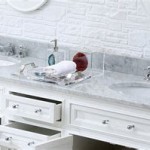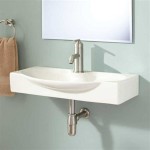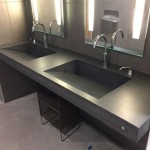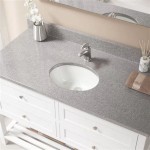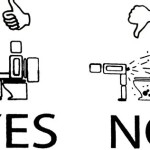Small Bathroom Lighting Ideas: Illuminating Your Compact Space
Small bathrooms present unique design challenges, and lighting is often a critical element that can significantly impact the overall feel and functionality of the space. Maximizing light in a small bathroom can make it appear larger, brighter, and more inviting. Thoughtfully planned lighting schemes are essential for both task-oriented activities, such as shaving and applying makeup, and for creating a relaxing and ambient atmosphere.
When space is limited, every design decision must be deliberate. Standard lighting solutions might overwhelm a small bathroom, leading to a cluttered and claustrophobic sensation. Therefore, creativity and strategic planning are vital in optimizing lighting. This article explores various lighting ideas specifically tailored for small bathrooms, incorporating different light sources and techniques to achieve a well-lit and aesthetically pleasing environment.
Optimizing Natural Light
The most effective way to brighten any room, including a small bathroom, is to maximize natural light. Natural light not only enhances the room's visual appeal but also has positive effects on mood and well-being. When possible, consider strategies to increase the amount of sunlight entering the bathroom.
Window Placement and Size: If renovating or building, carefully consider the size and placement of windows. Larger windows, even if frosted or obscured for privacy, will allow more natural light to enter. Positioning windows strategically, such as higher up on the wall, can provide ample light while maintaining privacy. Skylights and sun tunnels are also excellent options for introducing natural light from above, particularly in bathrooms with limited exterior wall space.
Light-Reflecting Surfaces: Even with limited natural light, the strategic use of reflective surfaces can amplify its effect. Light-colored walls, especially white or pale shades, will bounce light around the room, making it feel brighter and more spacious. Glossy finishes on tiles and countertops contribute to reflection, further enhancing the diffusion of light. Large mirrors are another invaluable tool for reflecting natural light, effectively doubling its impact.
Minimizing Obstructions: Avoid blocking natural light with heavy curtains or blinds. Opt for sheer curtains, translucent window films, or top-down/bottom-up shades that allow light to filter through while maintaining privacy. Regularly clean windows to ensure maximum light transmission. Prune any trees or bushes outside the window that may be obstructing sunlight.
Layering Artificial Lighting
While optimizing natural light is crucial, artificial lighting is essential to supplement it, especially during evenings or in bathrooms with limited or no windows. A well-designed lighting scheme should incorporate multiple layers of light to cater to different needs and create a balanced atmosphere. These layers typically include ambient lighting, task lighting, and accent lighting.
Ambient Lighting: Ambient lighting provides overall illumination for the bathroom. It is the primary source of light and sets the tone for the space. In small bathrooms, avoid large, bulky fixtures that can dominate the room. Instead, consider recessed lighting, flush-mount fixtures, or semi-flush-mount fixtures that sit close to the ceiling and distribute light evenly. These options minimize visual clutter and maximize headroom.
Task Lighting: Task lighting is focused illumination designed to assist with specific activities, such as shaving, applying makeup, or getting dressed. The most important task lighting is typically found around the mirror. Sconces mounted on either side of the mirror provide balanced and shadow-free lighting, which is ideal for grooming. Linear LED fixtures positioned above the mirror are another effective option, offering consistent and even illumination. Avoid placing a single light directly above the mirror, as this can cast unflattering shadows.
Accent Lighting: Accent lighting adds visual interest and highlights specific features in the bathroom. It is used to create a mood and enhance the overall aesthetic. In small bathrooms, accent lighting can be subtle but impactful. Consider adding strip lighting under the vanity to create a floating effect, illuminating niches or shelves to showcase decorative items, or using a small spotlight to highlight a piece of artwork. Dimmable switches allow for adjusting the intensity of accent lighting to create a relaxing spa-like atmosphere.
Choosing the Right Light Fixtures
Selecting the right light fixtures is paramount for both functionality and aesthetics in a small bathroom. Consider factors such as size, style, light output, and energy efficiency when making your selections.
Space-Saving Fixtures: Given the limited space in small bathrooms, opt for fixtures that are compact and streamlined. Recessed lighting is an excellent choice for ambient lighting, as it is unobtrusive and provides a clean, modern look. Surface-mounted LED fixtures can also be a good option, offering a similar effect with minimal protrusion. Wall sconces are ideal for task lighting around the mirror, as they save space compared to bulky vanity lights.
Light Output and Color Temperature: Light output, measured in lumens, determines the brightness of the light. For general ambient lighting, aim for a lumen output that provides adequate illumination without being overwhelming. Consider a color temperature ranging from 2700K to 3000K for a warm and inviting atmosphere, or 3500K to 4000K for a brighter, more energizing light. For task lighting, a slightly cooler color temperature (4000K-5000K) is often preferred, as it provides better visibility for grooming and makeup application.
Energy Efficiency: Opt for energy-efficient lighting options, such as LED bulbs. LEDs are significantly more energy-efficient than traditional incandescent or halogen bulbs, consuming less energy and lasting much longer. This can result in significant cost savings over time and reduces your environmental footprint.
Style and Design: The style of light fixtures should complement the overall design aesthetic of the bathroom. Choose fixtures that are cohesive with the existing decor and reflect your personal style. Modern bathrooms often feature clean lines and minimalist designs, while more traditional bathrooms may incorporate more ornate fixtures. Consider the finish of the fixtures, such as chrome, brushed nickel, or matte black, to coordinate with other hardware in the bathroom.
Specific Fixture Types and Placement Considerations
Vanity Lighting: As the focal point for many grooming tasks, vanity lighting requires careful thought. Sconces placed on either side of the mirror at eye level offer the most balanced and flattering light. The distance between the sconces and the mirror should be proportional to the mirror's size. Linear LED bars above the mirror are a popular alternative, providing even illumination across the face. Ensure the fixture is rated for damp locations.
Shower Lighting: Lighting inside the shower or tub area requires special consideration due to the presence of moisture. Use recessed lighting fixtures that are specifically designed for wet locations and are rated for use in showers. Consider installing a dimmer switch to adjust the brightness and create a relaxing atmosphere for bathing. Ensure all electrical work is performed by a qualified electrician and complies with local building codes.
Under-Cabinet Lighting: Installing LED strip lights under the vanity cabinets can create a subtle and ambient glow, adding a touch of elegance to the bathroom. This type of lighting is especially effective in small bathrooms, as it provides a soft, indirect light source that enhances the overall ambiance.
Recessed Lighting: Recessed lighting is an excellent choice for general ambient lighting in a small bathroom. Use multiple recessed lights spaced evenly across the ceiling to provide consistent and balanced illumination. Choose the appropriate size and wattage for the fixture based on the size of the bathroom and the desired light output.
Careful planning and consideration of these factors will result in a well-lit and aesthetically pleasing small bathroom that maximizes both functionality and visual appeal. The strategic combination of natural light, layered artificial lighting, and appropriate fixture selection can transform a cramped space into a bright and inviting sanctuary.

Ideas For Improving Your Bathroom S Lighting And Style Beautiful Homes

7 Ideas For Better Lighting In A Small Bathroom
:strip_icc()/101741513-50a4d6ea34ce48a3a1c7da0aa48463c3.jpg?strip=all)
30 Bathroom Lighting Ideas For Every Decorating Style

Vanity Lighting Guide The Home Depot

10 Bathroom Lighting Ideas For Every Design Designcafe

Small Bathroom Lighting Tips Unique Vanities

Everything You Need To Perfect Small Bathroom Lighting

11 Small Bathroom Lighting Ideas Tips For Better

15 Bathroom Lighting Ideas For Small Large

5 Design Ideas For Small Bathrooms Vigo Blog Kitchen Bathroom And Shower
Related Posts


